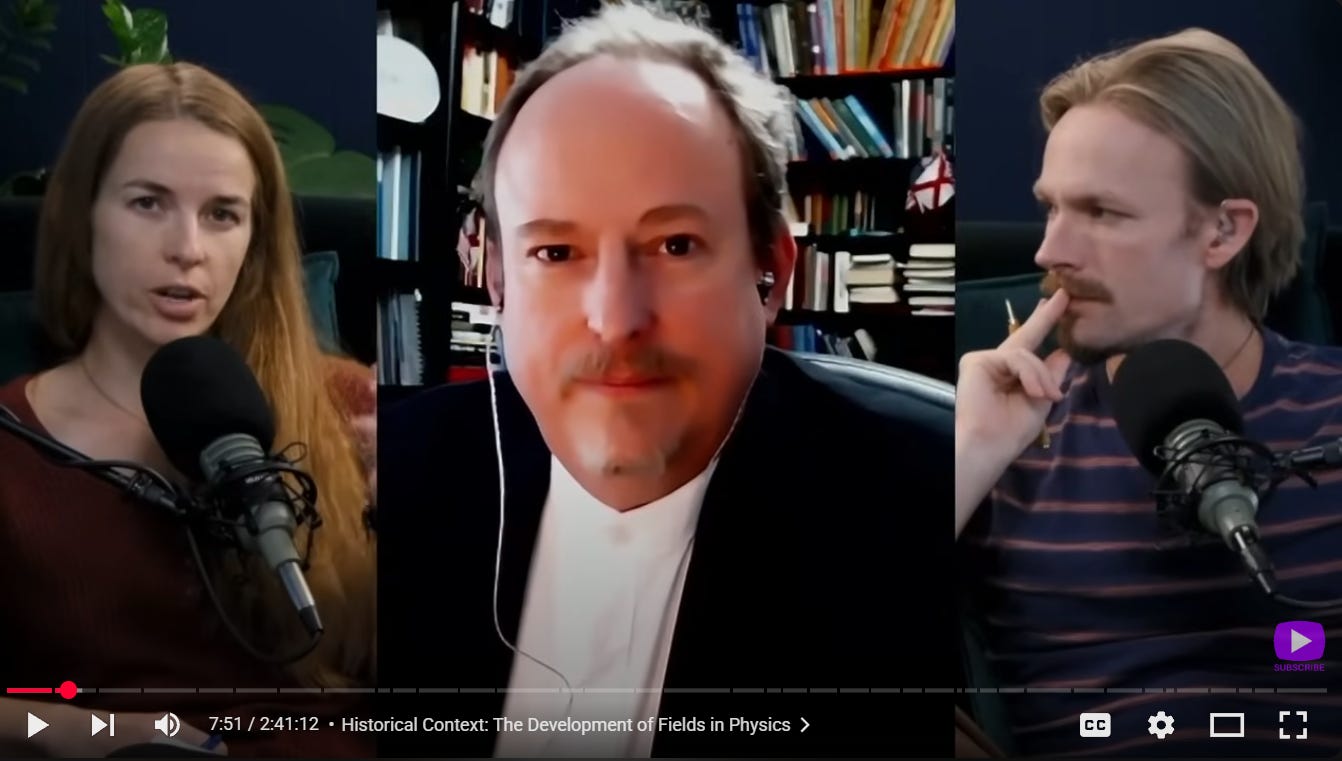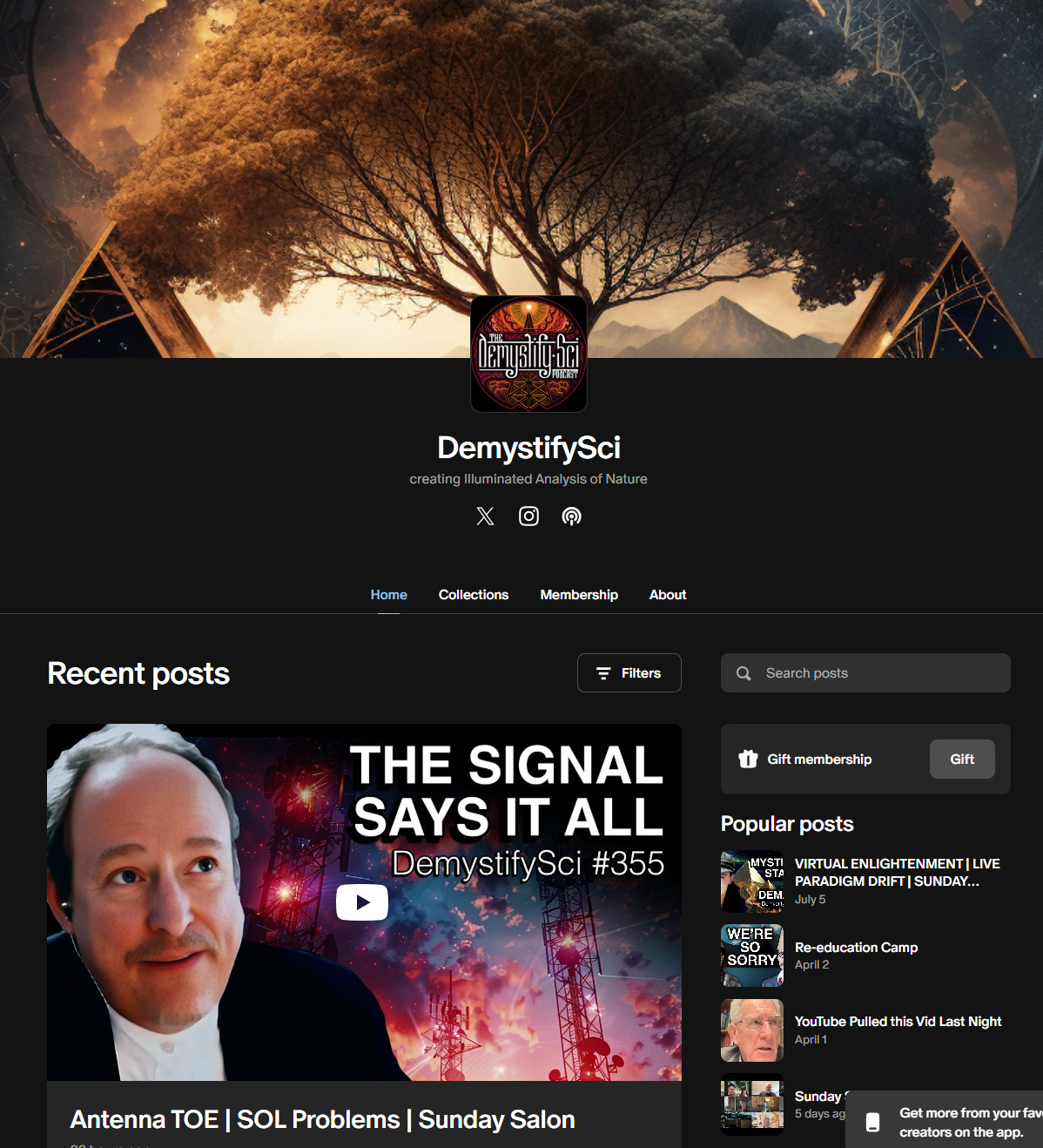DemystifySci to Discuss Fields & Energy
Sign Up for a 10 am PDT Conversation Tomorrow (Sunday)!
The crowdfund campaign for Fields & Energy Book I: Fundamentals and Origin of Electromagnetism, continues to roll along. Click through and back to be one of the first to get a copy, and pick up some SPQR accessories and some of my fiction, too!
I had a great conversation with Anastasia and Shilo at DemystifySci this past week. You can watch our conversation before it's made available to the public, and you can participate in a group discussion about it tomorrow (Sunday) at 10am PDT, if you sign up to be a member of their community, here:
Direct link, here: https://www.patreon.com/c/demystifysci/posts
Enjoyed the article, but maybe not quite enough to spring for a paid subscription?
Then click on the button below to buy me a coffee. Thanks!
Follow Online:
You may follow me online in other places as well:
Telegram: 𝔸𝕖𝕥𝕙𝕖𝕣𝕔𝕫𝕒𝕣'𝕤 𝔸𝕖𝕥𝕙𝕖𝕣𝕤𝕥𝕣𝕖𝕒𝕞
Gab: @aetherczar
Twitter: @aetherczar
Amazon: Hans G. Schantz







Experiments and theory by many researchers now show that the speed of light is not constant speed c across space, and that instantaneous signaling is observed in the nearfield of EM sources, disproving both the 2nd premise in Relativity, and Relativity's prediction that signals cannot propagate faster than light. What remains is the 1st premise : Galilean Relativity. If Relativity is wrong then so is any theory based on it like, General Relativity and QED.
An experiment just published in the EM journal IRECAP shows an EM pulse propagates instantaneously in the near field across 1.5 meters of space with no propagation delay. This shows that the front speed (speed of information) or speed of causal action is instantaneous in the nearfield of EM sources. The experiment was repeated hundreds of times, and also done by an independent researcher in their own lab, with exactly the same results. The paper also shows that the effect is predicted exactly by Maxwells equations. The paper is linked below. The effect can also be shown to be fundamentally due to the Heisenberg uncertainty principle. This shows that the effect is fundamental to all fields including: EM, gravity, and quantum.
In another experiment, a sinusoidal signal was transmitted between 2 dipole antennas as they were separated from the nearfield to the farfield. Analysis of the resultant phase vs distance curves (dispersion curves) shows a clear minima in the nearfield for all the EM field components. Applying well known phase speed and group speed operators to the curve, which are inversely proportional to the slope of the curve, show that both the phase speed and group speed are instantaneous in the nearfield and reduces to about speed c in the farfield.
Both experiments have been independently repeated by other researchers, obtaining the same exact results. If speed of light is not constant, then the 2nd premise in Relativity is wrong and what remains is the 1st premise: Galilean Relativity. Instantaneous signals violate the Relativity of Simultaneity because the signals appear the same in all inertial frames of reference. This can easily be seen by inserting c=infinity into the Lorentz transform, yielding the Galilean transform, where time and space are absolute. So if a moving body is observed with instantaneous nearfield light, then no Relativistic effects will be observed. But they will be observed if the frequency of the light source is changed such that farfield speed c light is used. So by simply changing the frequency of the source, Relativistic effects can be turned off and on. The only possible explanation is that the effects of Relativity are not real and are just a type of optical illusion. This result will affect all of modern physics.
In addition, the above results are predicted by EM theory. Maxwell's derivation of the speed of EM fields was wrong. The reason is that EM fields are created by sources coming from Gauss' and Amperes laws., and these sources must be included and can not be set to zero as Maxwell did. Including the source term yields a wave equation equal to a source term. Inserting a dipole source yields EM field components that with phase vs distance from the sources dispersion curves with a clear minima in the nearfield, and become only approximately linear in the farfield, starting about 1 wavelength from the source. It is well known that both the phase and group speed are instantaneous when there is a minima in the curve, and only exactly a constant speed when the curve is exactly linear, which only occurs at infinite distance from the source, which does not occur in a finite sized universe like ours. So Maxwell's solution is only valid at infinity, which does not exist in this finite sized universe. So the speed of light never a constant in our universe. If the speed of light is not constant, then the 2nd postulate in Relativity is wrong.
The same behavior can be shown to occur in gravity. It is well known that general relativity reduces to gravitoelectromagnetism (GEM), which assumes that gravity can be modeled by Maxwell's equations with different constants. So the same solution that occurs in EM theory also pertains to gravitational theory. This explains the instantaneous gravitational effect in the near field, observed in the stability of the planets, and also explains that Gravity waves have been observed to propagate at about speed c in the far field. This theory then accounts for all the observed gravitational effects including instantaneous nearfield and the speed of light farfield. The main difference is that this theory is a field theory, and not a geometrical theory like General Relativity. But because it is a field theory, Gravity can be then be quantized as the Graviton, enabling the unification of Gravity and Quantum Mechanics.
The phenomena also can be seen in quantum theory, and can be shown to be the consequence of the Heisenberg uncertainty principle. At the source, the position of the photon emitted from the source is precisely well known, hence the momentum or the speed is infinite. At about 1 wavelength from the source, the wavelength is starting to be come clear, such that frequency x wavelength ~c. But according to Fourier Theory infinite cycles are needed for the wavelength to be exactly known. So the above frequency wavelength relation is only valid at infinite distance from the source. So the speed of light never reduces to exactly speed c in our finite size universe. This phenomena should be fundamental to all fields including: EM, gravity, and quantum, and in particular quantum tunneling.
There are currently many interpretations of quantum mechanics. But only the Pilot Wave Interpretation is compatible with Galilean Relativity. In this interpretation real particles are guided by real pilot waves. But the real pilot waves are known to communicate information about the particles instantaneously with the environment. Because this is not compatible with Relativity Theory, this interpretation has not been taken seriously. But as a result of this discussion, this is no longer a problem, and Pilot Wave theory should now become our best interpretation of quantum mechanics. And combined with instantaneous nearfield interaction, can perhaps explain the instantaneous interaction observed in quantum entanglement.
For more information see the following links:
*YouTube presentation summarizing my 35 years of research in this area: https://www.youtube.com/watch?v=sePdJ7vSQvQ&t=0s
*More extensive paper for the above arguments: William D. Walker and Dag Stranneby, A New Interpretation of Relativity, 2023: http://vixra.org/abs/2309.0145
*Electromagnetic pulse experiment paper peer reviewed and just published last month in Journal IRECAP: https://www.techrxiv.org/doi/full/10.36227/techrxiv.170862178.82175798/v1
Dr. William Walker - PhD in physics from ETH Zurich, 1997